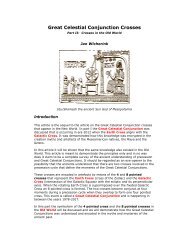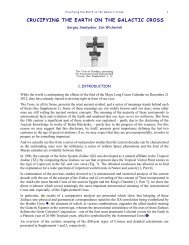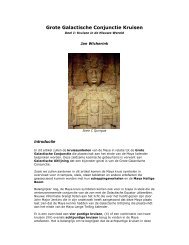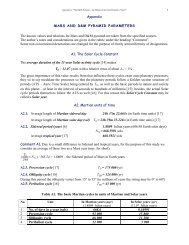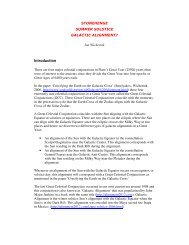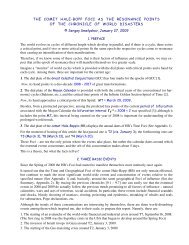THE D&M PYRAMID OF CYDONIA â THE ... - Souls of Distortion
THE D&M PYRAMID OF CYDONIA â THE ... - Souls of Distortion
THE D&M PYRAMID OF CYDONIA â THE ... - Souls of Distortion
You also want an ePaper? Increase the reach of your titles
YUMPU automatically turns print PDFs into web optimized ePapers that Google loves.
The D&M Pyramid – the Sibling <strong>of</strong> the Great Pyramid <strong>of</strong> Giza? 10<br />
2.3.2. D&M-GP direct connection<br />
It is known that the perimeter <strong>of</strong> the Great Pyramid <strong>of</strong> Giza (about 921.43 m) makes ½ <strong>of</strong> the length <strong>of</strong> the<br />
geographical mile (the exact value <strong>of</strong> its length for the Giza latitude makes 1847.56 m), or ½ <strong>of</strong> arc min <strong>of</strong><br />
Equatorial circumference <strong>of</strong> the Earth [4, 5]. From this we may conclude that the primal side length a <strong>of</strong><br />
the D&M pyramid makes twice the perimeter <strong>of</strong> the Great Pyramid <strong>of</strong> Giza, or 8 times its side.<br />
If so we may presume that applying the Egyptian cubit (with an integer multiple, e.g. 2 or 8) to the D&M<br />
may result, as in the case <strong>of</strong> the GP, in obtaining <strong>of</strong> some important geographical and/or geometrical<br />
information. And it is actually so; thus, consider the number a* = 1.16479 (miles) the rounded-<strong>of</strong>f value<br />
<strong>of</strong> which (1.16) coincides with the average for the existing estimates <strong>of</strong> primal side length a in miles.<br />
Then the perimeter <strong>of</strong> the D&M in cubits (1 cubit = 0.524 m) makes<br />
6.038077 × 1.16479 × 1609.3<br />
P EC =<br />
= 21 600. (24)<br />
0.524<br />
Therefore, Within the source data accuracy the perimeter <strong>of</strong> the D&M pyramid in Egyptian cubits makes<br />
the number N = 21600 <strong>of</strong> arc minutes in a circle (360× 60 = 21600).<br />
m<br />
2.3.3. Several more Geographical Certificates <strong>of</strong> the D&M pyramid<br />
In Martian Equatorial miles [A3], or arc minutes, the primal side length a makes<br />
1.15 × 1.6093<br />
Φ<br />
aE = 1.15 × 1.6093 / λ E =<br />
= 1.87 (arc min) ≅ ( δ = 0.01 %)<br />
0.98975<br />
e π<br />
and coincides with the ratio <strong>of</strong> areas (22) <strong>of</strong> the pentagon and hexagon related faces.<br />
So, once again it is expressed in the primal DM constants. Moreover, by dividing the length <strong>of</strong> Equator by<br />
this value we obtain<br />
(25)<br />
360 × 60<br />
TPH<br />
= = 11551. (26)<br />
a<br />
Within the accepted tolerance this value presents half <strong>of</strong> the Perihelion cycle <strong>of</strong> 22 900 Martian years<br />
[Table A1]. To this end it is important to note that, in contrast to Earth, this cycle is evidently more<br />
pronounced for Mars than the cycle <strong>of</strong> precession (93 000 Martian years) due to its duration and<br />
significant difference in Aphelion/Perihelion distances [6]<br />
Perihelion distance: 1.381 AU ≅ 2 −Φ<br />
( 0.04%)<br />
;<br />
Aphelion distance: 1.666 AU ≅ Φ ( 3%)<br />
.<br />
E<br />
In D&M-latitudinal miles [A3], or D&M-latitudinal arc minutes, the primal side length a coincides with<br />
the area S (See Table 1), its approximant and also exactly approximated by 4 ϕ .<br />
1.15×<br />
1.6093<br />
aDM = 1.15×<br />
1.6093 / λ D =<br />
= 2.4723 (arc min) =<br />
0.748578<br />
⎧<br />
⎪2.478484<br />
( δ = 0.2%),<br />
⎪<br />
⎨4<br />
× ϕ ( δ = 0.006%),<br />
⎪ e<br />
⎪ + Φ , ( δ = 0.4%).<br />
⎩π<br />
(27)





